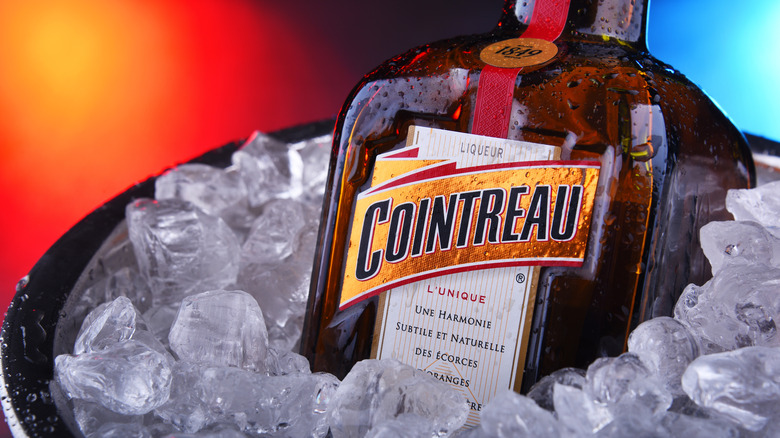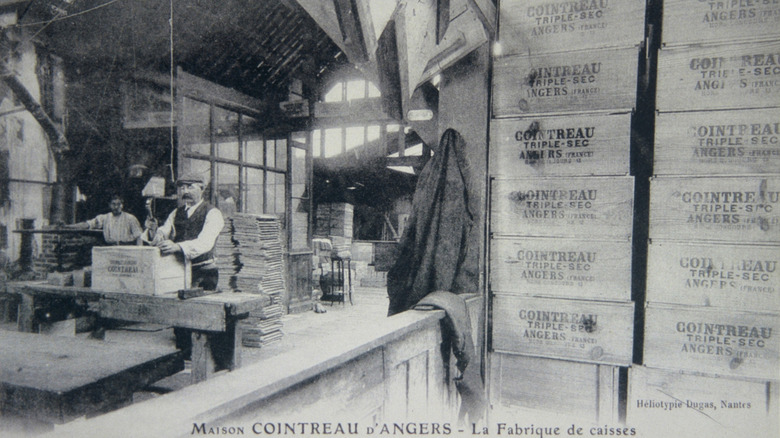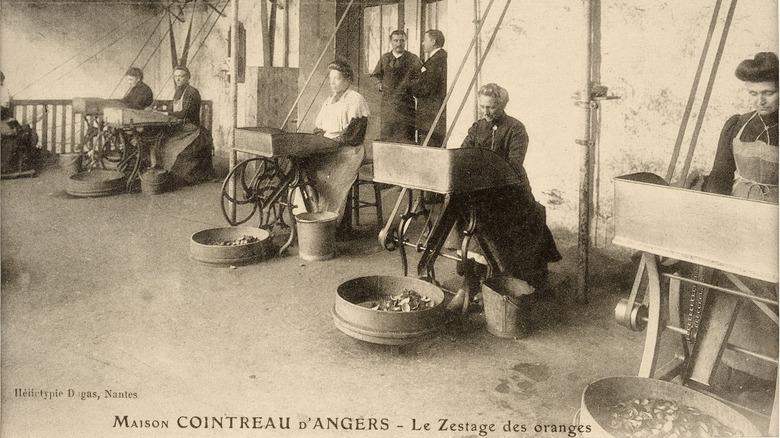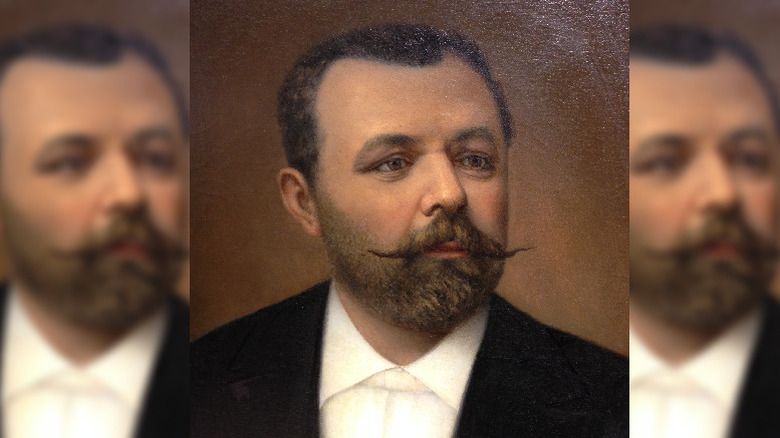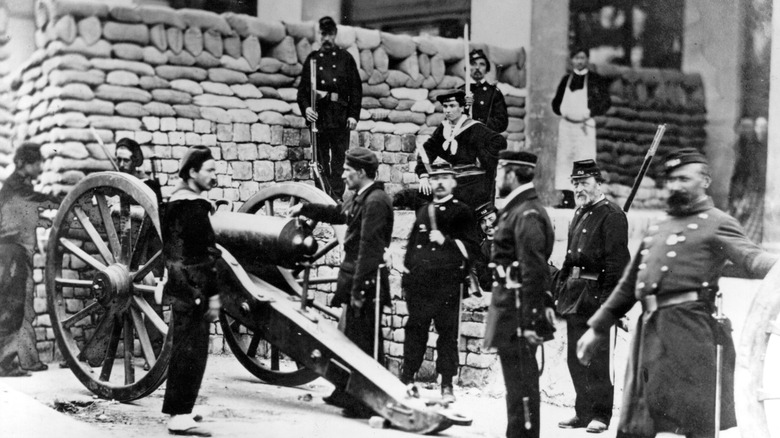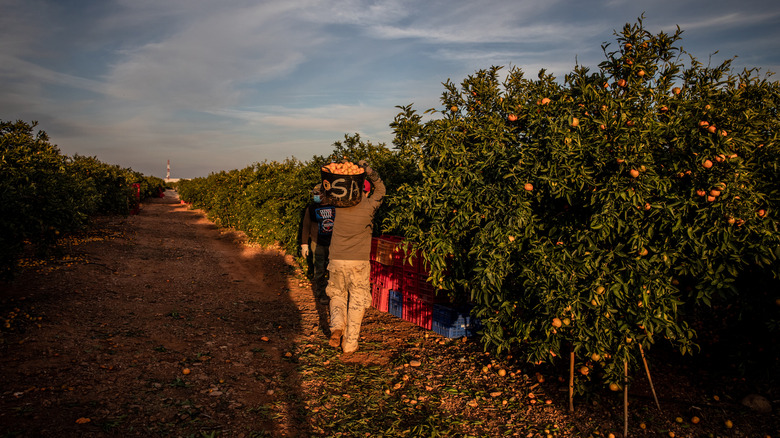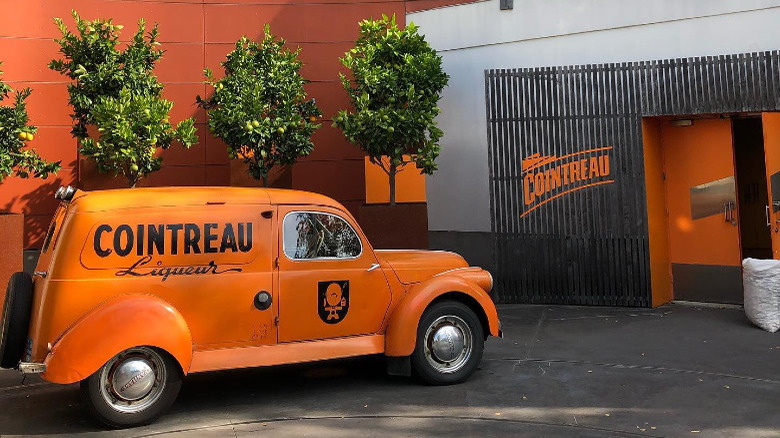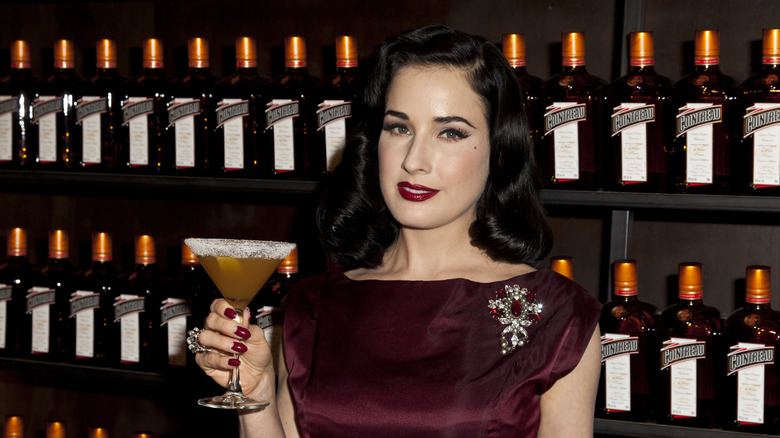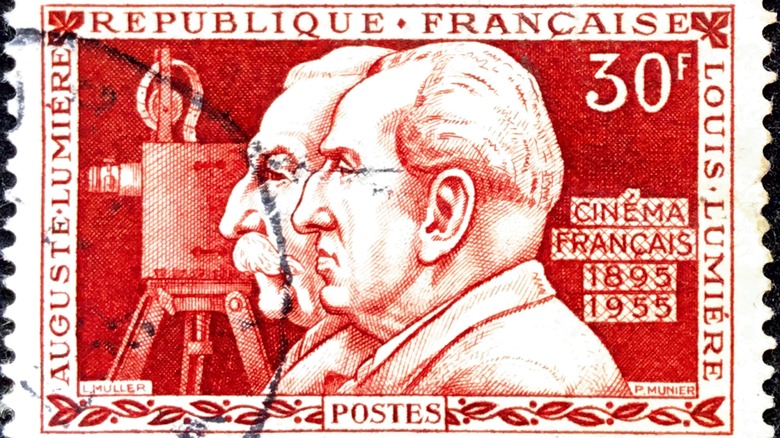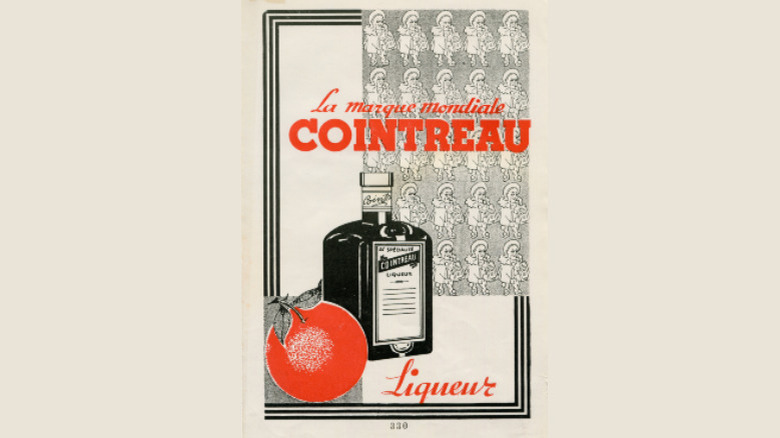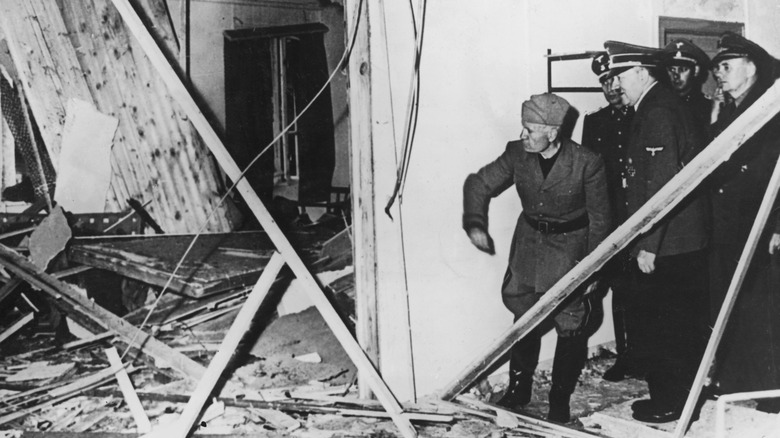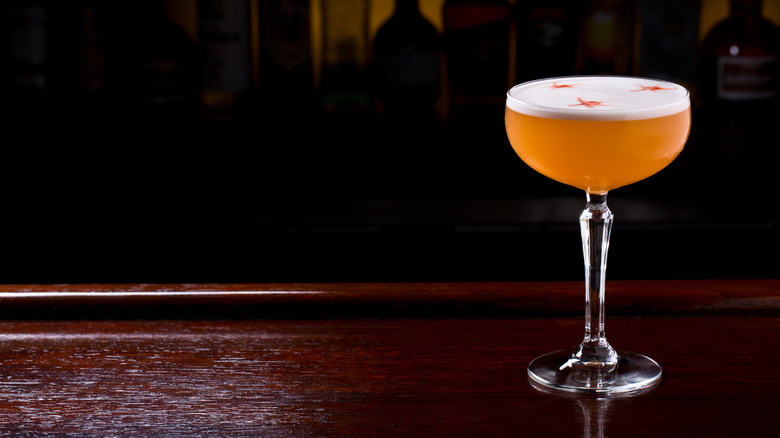The Untold Truth Of Cointreau
It's hard to think of a cocktail ingredient more impactful than Cointreau. After all, this stalwart triple sec is called for in everything from a Margarita to a Cosmopolitan, and tastes great as a spritzer or as an after-dinner sipper on the rocks. A serious cut above the bargain brand orange liquors, but still affordable enough to keep stocked in the home bar, this versatile spirit is the original bartender's ketchup — viable with just about anything you care to throw in a shaker. And with a story dating back to the Second French Empire, there is a lot of lore behind this subtle orange liqueur.
Still a family-run business, the Cointreau's have been movers and shakers in Angers France for generations, from confectioners to soldiers, entrepreneurs, inventors, and eventually to an alcohol empire. But there can be a lot of fiction mixed into the facts in all of those legends, so let's get down to the untold truth of Cointreau.
The Cointreau brothers began as confectioners before turning to booze
It makes perfect sense that the creators of one of the world's most respected liqueurs would have started out making candy; sweet liquors and sweet eats do tend to share a similar palate. With so much experience sourcing and working with natural fruits, it surely gave them an advantage over their competition. When brothers Edouard-Jean and Adolphe Cointreau began making booze, they started with a classic French wild cherry liqueur called Guignolet, which they still make today (via Food & Wine).
With the success of their guignolet, they began expanding their product line, and before long they manufactured over 50 liqueurs. Adolphe's penchant for processing a wide range of fruit into pungent candied flavors earned them a reputation for quality spirits with rich fruit flavors. As Willy Wonka said, "Candy is dandy, but liquor is quicker." But their most popular product wouldn't be developed until Edouard-Jean's son Edouard began developing his own spirits for the brand.
Cointreau is made up of a wide variety of oranges
When Edouard began making his orange liqueur, he wanted to make something different from the tawny curacao that littered the market. So rather than using Brandy as his base spirit like most of the distillers of the time, he distilled a clear spirit made of beets. The deeply nuanced layers of flavors in a triple sec, especially one as artfully made as Cointreau, come from distilling several types of orange. Sweet orange (Citrus sinensis) builds a juicy body to the liquor, and adds the floral, fruity element to the blend. It takes a mix of seven kinds of sweet orange to compose this single element of the spirit. Then there's the bitter orange (Citrus aurantium), which comprises the more acidic, zesty, and spicy flavors inherent in Cointreau.
Using just the peels of the oranges, certain varieties are macerated in alcohol to extract the necessary oils. Then they are sun-dried for up to five days before the master distiller portions them into what they deem to be a proper blend, with a high priority placed on the aromatics of the blend. Because, as any flavor developer knows, our taste is often dictated by smell.
Cointreau claims to have invented the term triple sec, but that's up for debate
Edouard Cointreau expressed disappointment in the popular varieties of orange liqueurs at the time, finding them too sweet and one-dimensional, and became determined to create a more pristine product. What he wound up introducing in 1885 was a clear liqueur — in stark contrast to the more commonplace murky brown curacaos of the day — that he claimed was three times as concentrated and less sweet as compared to other brands. Hence labeling it with the term "Triple Sec," literally meaning "thrice dry." Other sources cite Cointreau as claiming that the term originates from the three different types of orange used in the manufacturing process; dried sweet peels, dried bitter peels, and freshly macerated sweet peels.
The origin of the term is debated, however, as Combier also claims to have coined the label Triple Sec in Samur, France. Jean Baptiste Combier's claims date back to 1834, when the term was used to imply that their product was triple distilled. We're more inclined to believe Combier, as their product is nearly 40 years older than Cointreau, whose legends seem murkier than the old curacaos they set out to improve. Either way you peel it, the big benefit for triple sec producers of the day was that unlike most boozy sippers of their time, triple sec did not require aging, meaning their product reached the shelves in a much more timely and profitable manner, allowing Cointreau to grow exponentially.
Edouard Cointreau was inspired to make triple sec by seeing people's craving for orange liqueur in the Franco-Prussian war
The Franco-Prussian War was an extremely consequential 10-month event, one that, in many ways, would dictate the destiny of Europe leading up to World War I and eventually World War II. One of the less consequential, but long term impactful effects of that war was a detail that caught a certain soldier's eye; Edouard-Jean Cointreau's son, Edouard, served the losing French effort in the war, and during his travels noticed a particular flavor catching on throughout the European heartland.
Oranges were a luxury to the everyman of late 1800s Europe. Primarily grown in warm, tropic regions and requiring long travel distances to reach the core of France, those logistics made them quite a costly treat, largely left to the wealthy. While a Bugatti or a Rolex might display your social status today, back then it was Orange trees (via Food & Wine). Since most people couldn't afford fresh oranges, orange-flavored sweets became en vogue and oranges themselves became prized treats. But Edouard saw a lust for the exotic fruit throughout the country in his tour of duty, and when he returned to the distillery where he had grown up, he began his quest to bring that citrus flavor to the lips of every thirsty consumer, preserved perfectly in a subtly sweet liqueur.
This globe trotting curacao is made with oranges sourced from Brazil, Tunisia, Ghana, Senegal, and Spain
Part of Edouard Cointreau's quest for the perfect orange liqueur was to source the perfect blend of oranges. He traveled around the world to personally select the best oranges he could find in the finest terroirs. After all, if one is going to satiate their fellow countryman's craving for the exotic flavors of oranges, why not source them from the most exotic places? And as any Frenchman growing up in the heart of the Loire Valley wine country would understand, Edouard knew that the terroir of a place will dictate the flavor of its fruit.
Sevilla Spain, Ghana, Senegal, and Brazil provide the Cadenera, Salustiana, Pera, Late Valencia, Sweet Mediterranean, Washington, and local Ghanaian varieties of sweet orange peel, while Brazil and Tunisia provide the Bigarade bitter oranges that make up the nuanced flavor of this long prized triple sec. So when you sip Cointreau, you are quite literally tasting a world of oranges.
The Cointreau recipe hasn't changed since 1923
There is always something to be said for consistency, particularly among brands that have been around for over 170 years. Despite a sale to Cognac giant Remy Martin in 1989, Cointreau is still a family-run business, with Alfred Cointreau serving as the fifth generation to run the distillery. Despite sourcing produce from around the globe, he says the distillery's primary goal is to preserve the recipe that Edouard developed all those years ago.
In the 1900s, the spread of Cointreau was largely assisted by an English wine trader named George Glendenning who distributed the liquor in the U.K. But in 1923, he complained that their market was slipping because the spirit was too sweet for British palates. So Edouard Cointreau produced a drier version, which became the version distributed throughout the world and the recipe is still used to this day.
As Alfred told Food & Wine: "You can taste the Cointreau of this year, last year and 15 years ago ... it's the same. That is the challenge for us, to keep this consistency because, as you can imagine, the oranges peels from Africa or South America are all different. We know all the farmers, all of the suppliers of our orange peels and every year that is a rule of the master distiller is to choose the best orange peel through the farmers to make sure she can replicate exactly the same recipe."
Cointreau were pioneers of advertising, contracting innovative artists like Charles Loupot
Perhaps one of the most novel developments by Cointreau has been its innovative approach to marketing. In 1898 it established its own in-house advertising studio, contracting renowned portrait artist Nicolas Tomango to create Pierrot Cointreau, a comedic, bespectacled clown that would become the mascot. The company even built a giant square Cointreau bottle onto the back of a car in 1903 to serve as a mobile advertisement.
By 1930 the brand hired renowned poster artist Charles Loupot who abstracted and reimagined Pierrot in his own style, using gradient oranges and orange peel like textures. The only thing still distinguishing him as Pierrot being those iconic glasses — a subtle joke referring to Edouard Cointreau's myopia. Illustrator Jean Mercier – grandson of Edouard — would begin his career by taking his own stab at the ad in 1938, depicting an orange popping open like a clam shell to reveal a bottle of Cointreau, and a surprised Peirrot losing his glasses in the action.
More recent advertisements have seen Cointreau flirting with the Queen of Burlesque herself, Dita Von Teese, who teased her own cocktail, the MargaDita in 2011, on the heels of a sauced up ad campaign. But the mid-COVID-19 pandemic Super Bowl commercials ditched the usual glitz and glamor to show the beverage's support for the Independent Restaurant Coalition and its dependence upon the service industry workers who were largely shut out of work at the time.
Cointreau made the first filmed advertisement in history
The credit for the invention of movies often goes to Thomas Edison, and William Dixon, and while the team was largely responsible the Kinetoscope and some of the first documented motion pictures, it was a pair of French brothers who turned small scale experimentations in film into what we regard today as cinema. In 1895, fresh home from seeing Edison's Kinetoscope for themselves, August and Louis Lumiere created their cinematograph, a camera built to not only film, but also develop and project motion pictures. In 1895 at the Salon Indien in the basement of the Grand Cafe in Paris, the brothers screened 10 short films before a small audience in an event that would be regarded as the birth of the cinema. What does this have to do with Cointreau, you might ask?
Beyond the legacy of Cointreau's brilliance in the medium of print advertising sits a distinguishing innovation. In 1898, just three years after the Lumiere brothers had practically invented the concept of cinema, Cointreau contacted them to develop an ad featuring their mascot Pierrot Cointreau, marking what many claim to be the first ad ever to appear on film.
Cointreau removed the term triple sec from its label between World Wars
When Edouard Cointreau first created his orange-laden spirit, he originally labeled it "Triple Sec Cointreau," and that is the name it bore up through World War I. But as distribution systems made oranges more prevalent and the supply of various brands of triple sec began to expand, the market was flooded with cheap, syrupy, cut-rate brands of triple sec. Wanting to differentiate between the bottom shelf bottles and their high-quality spirit, Cointreau removed the term triple sec from the label sometime between World War I and World War II, according to Difford's Guide. From then on it was labeled "Curacao Blanc," perhaps because Curacao was popular at the time and it wanted to take advantage of the market while still differentiating themselves from the brown liqueurs that littered the shelves. But, once again, it removed the term as cheap alternatives flooded the market.
Many spirits have regulations dictating what a product is called. For example, all bourbon is a kind of whiskey, but that doesn't mean that all whiskey is a kind of bourbon. Bourbon is highly regulated and must have a certain mash build, age in charred oak barrels, and be made in America. While curacao is believed to have originated on the Island of Curacao which was controlled by the Dutch at the time, there is no legal delineation between it and triple sec, despite the attempts to distinguish themselves by both Combier and Cointreau.
An attempt to assassinate Hitler used an explosive carried in a Cointreau case
In the middle of World War II, during the invasion of the Soviet Union in 1941, Major General Henning von Tresckow began organizing a coup on Adolph Hitler called Operation Spark. Known as the Black Band, the group made several attempts to assassinate the tyrant, the most famous of which was depicted in the 2008 Bryan Singer film "Valkyrie." But a lesser-known attempt, the Cointreau bomb plot, came incredibly close to success.
The story goes that during one of Hitler and Himmler's visits to the Eastern Front, Tresckow asked a Lieutenant traveling with Hitler for a favor and arranged for him to deliver a case of Cointreau to Tresckow's friend, Colonel Helmuth Stieff who worked in East Prussia at Hitler's Headquarters (via The Drinks Business). Only unbeknownst to the Lieutenant, that Cointreau case was filled with a payload of plastic explosives and a British pencil detonator — enough to decimate the plane carrying the two most powerful men in Nazi Germany. The plan was for the Black Band to blame the plane's explosion on the Soviet Air Forces, facilitating a flawless transition of power and a silent coup. Unfortunately for Tresckow, and the rest of the world, the cold temperatures in the cargo hold caused the detonator to malfunction and the bomb was never detonated.
Cointreau helped usher in the modern cocktail boom
Perhaps Cointreau's lasting legacy will be that of its cocktails. Difford's Guide cites over 370 cocktails calling specifically for Cointreau, and it's tagged in so many classic tipples that it wouldn't be a stretch to credit it with both the creation and the revitalization of the cocktail movement. In 1922, Robert Vermiere's "Cocktails: How to Mix Them" and Harry MacElhone's "The ABC's of Mixing Cocktails" introduced the world to the Sidecar, a recipe that requests any old Cognac, but specifically calls for Cointreau by name. The same goes for the first printing of a Margarita in the Albuquerque Journal in 1937, which called for "tequila," but specifically Cointreau.
While the 1980s did a number on degrading cocktails, popularizing syrupy liquors and sugary mixers, New York's Toby Cecchini of the Odeon bar took a swing at classing up a trendy drink, changing cocktail history forever. Following its origins as a riff on a Kamikaze in a Cleveland gay bar, Cecchini decided to make his version of the Cosmopolitan using fresh lime juice, Citron vodka, cranberry juice, and, you guessed it, Cointreau (via Punch). It was his version that spread like wildfire across the country thanks to the ubiquity of "Sex in the City." All of the era's cocktail gods — Cecchini, Dale Degroff, and the like — agree that nothing did more to progress the return of craft mixology with real ingredients than the Cosmo, and all of them used Cointreau to do it.
